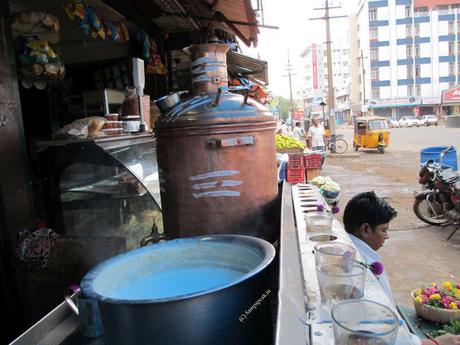
Coffee berries, which contain the coffee seeds, are produced by several species of a small evergreen bush of the genus Coffea. The two most commonly grown are also the most highly regarded Coffeaarabica, and the "robusta" form of the hardier Coffeacanephora. One Coffee advertisement used to ask – how much you know about the person whom you love most….. similarly can you instantly list out at least 5 persons whom you love or list out 5 things your city is famous for….In good olden days, whenever people used to travel they used to travel with coffee contained in ‘kooja’ [a special coffee pot] and then with flask-load(s) of coffee… be it a traveller, or somebody making it at home – concocting coffee without spilling … spillage and perhaps liability is altogether a different issue, interesting one at that.
All that is territorial ~ as one travel to North, in those parts of India, it is more of ‘chai’ than Coffee .. .. .. so what do you think, people of China drink ! – here is something interesting found in BBC. In 2005, Richard Chien opened a coffee shop in northeastern China, where an assembly line of novice baristas dished out 900 cups a day for 6 yuan – or less than a $1 – a pop. A decade later, he runs a classy coffee school in Beijing, where trainees spend hours contemplating bean aromas and tasting techniques for $6 brews. Chinese coffee consumption has nearly tripled in the past four years !!
Coffee is elbowing its way into tea culture in China, with the potential to transform one of the world’s smallest markets into its largest. The Chinese drink less than 2% of the world’s coffee, but already they’re reshaping the industry. The country’s “economics have changed; people more and more understand a different living style,” said Chien. “It’s no longer just about tea.”Chinese coffee consumption has nearly tripled in the past four years, according to the United States Department of Agriculture, faster than any other major market the agency tracks. And that potential market is vast: China’s population nears 1.4 billion. Starbucks is so confident it plans to open its first international roastery and tasting room next year in Shanghai, and believes the country could become its top market. The Seattle company, which already operates more than 2,000 stores in China, plans to add 500 shops annually for the next five years. Dunkin’ Donuts – another US chain known for its coffee – last year announced plans to add more than 1,400 locations over the next two decades, an increase of nearly 100-fold.Much of China’s younger generation is coming of age surrounded by Starbucks. Java’s rise exemplifies China’s swing toward a consumer-driven economy, fueled largely by changing desires of an expanding middle class. More Chinese are traveling abroad and have sipped espressos in Japan or finished term papers at US cafes. And unlike their parents, much of China’s younger generation is coming of age surrounded by coffee shops. The beverage still feels like an indulgence to many Chinese, he said, but it’s an accessible luxury. Coffee is an outlier in China’s cooling economy, where demand for other commodities is declining. The country’s massive population and a largely untapped market present unprecedented opportunity.An average mainland Chinese person drinks about three cups of coffee a year, which puts China near the bottom of the pile, just above countries like Sudan and North Korea. By contrast, the US gulps 363 cups per person and the UK ingests 250 cups a year, according to research firm Euromonitor International.China’s thirst for coffee will “totally change supply chains globally,” said Shaun Rein, managing director of Shanghai-based China Market Research Group. Growers will need to determine how to produce more coffee beans in response, he said, with flavours geared toward Chinese tastebuds. “This has happened in the past, where demand outpaces supply so the price of coffee beans skyrockets until farmers are able to plant more.”“I wouldn't be surprised if one day we have more stores in China than we do in the US,” Starbucks CEO Howard Schultztold CNBC in May. Shanghai alone has about 1,000 stores, making it one of the world’s largest concentrations of Starbucks outlets. Cafes with wi-fi and air-conditioning, where friends can gossip and entrepreneurs can hold meetings, are still more of a draw than what’s behind the counter. Nestle – maker of Nescafé instant coffee – dominates the market, and many Chinese who do drink coffee opt for instant packets that sell for less than a dollar in cramped corner stores. Coffee shops rarely open before 9am, and see much of their traffic later in the day. Even then, green tea lattes and frothy milk drinks proliferate.
Both taste and cost pose threats to China’s developing coffee market, particularly outside affluent urban areas. Makes an interesting read ! With regards – S. Sampathkumar 1st July 2016. News of China coffee ~ source BBC

